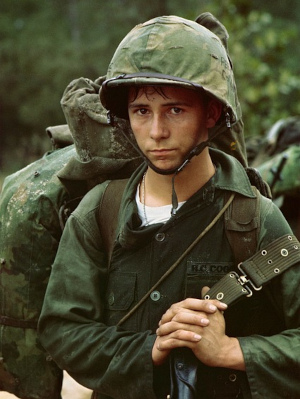During World War II, Vietnam was invaded by Japanese forces. To resist the Japanese and the French colonial administration, Ho Chi Minh formed the Viet Minh, which was inspired by Chinese and Soviet communism. After Japan’s defeat in 1945, they left Vietnam, and Emperor Bao Dai took control. Ho’s Viet Minh forces seized the opportunity and took over Hanoi, establishing the Democratic Republic of Vietnam with Ho as president. France supported Emperor Bao and created the state of Vietnam in July 1949, with Saigon as its capital, in an attempt to regain control of the region. Both sides desired a unified Vietnam, but Ho and his supporters aimed for a communist nation, while Bao and others wanted Vietnam to have strong ties with the West in terms of economy and culture.
The Vietnam War started in 1954 with the victory of the northern Viet Minh forces over the French at the Battle of Dien Bien Phu. The subsequent Geneva conference split Vietnam along the latitude known as the 17th Parallel, with Ho controlling the north and Diem leading the south.
During the Cold War, the United States supported South Vietnam against the Soviet Union’s allies. President Dwight D. Eisenhower backed Diem’s regime, which cracked down on Viet Minh sympathizers, known as Viet Cong. The Viet Cong fought back against the repressive regime, engaging in firefights with the South Vietnamese army. In 1960, opponents of Diem formed the National Liberation Front (NLF) to resist the regime, leading to tensions with Washington.
In 1961, President John F. Kennedy sent a team to South Vietnam to assess the situation. They recommended that the United States provide military, economic, and technical support to help Diem combat the Viet Cong threat. This was based on the belief that if one country in Southeast Asia fell to communism, others would follow. Kennedy followed this advice and increased U.S. aid, but did not commit to a full-scale military intervention.
In November 1963, a coup led by some of his own generals resulted in the overthrow and death of Diem and his brother, Ngo Dinh Nhu. This happened just three weeks before Kennedy was assassinated in Dallas, Texas. The political instability that followed in South Vietnam convinced Kennedy’s successor, Lyndon B. Johnson, and Secretary of Defense Robert McNamara to increase U.S. military and economic support.
In August 1964, after DRV torpedo boats attacked two U.S. destroyers in the Gulf of Tonkin, Johnson ordered the bombing of military targets in North Vietnam as a retaliation. Congress then passed the Gulf of Tonkin Resolution, which gave Johnson broad powers to wage war. The following year, U.S. planes began regular bombing raids, codenamed Operation Rolling Thunder.
The bombing was not limited to Vietnam alone. From 1964 to 1973, the United States covertly dropped two million tons of bombs on neighboring, neutral Laos during the CIA-led “Secret War” in Laos. The purpose of this bombing campaign was to disrupt the flow of supplies into Vietnam through the Ho Chi Minh Trail and to prevent the rise of Lao communist forces known as the Pathet Lao.
In March 1965, Johnson made the decision to send U.S. combat forces to Vietnam. By June, there were 82,000 combat troops stationed in Vietnam, and military leaders were calling for an additional 175,000 troops by the end of 1965 to support the struggling South Vietnamese army. Despite concerns from some of his advisers and the growing anti-war movement, Johnson authorized the immediate deployment of 100,000 troops at the end of July 1965, followed by another 100,000 in 1966. In addition to the United States, South Korea, Thailand, Australia, and New Zealand also sent troops to fight in South Vietnam.
By the end of 1967, the communist leaders in Hanoi were becoming impatient. They sought to strike a decisive blow to the well-equipped United States and make them give up on their hopes of winning. On January 31, 1968, General Vo Nguyen Giap led around 70,000 DRV forces to launch the Tet Offensive. This was a series of fierce attacks on over 100 cities and towns in South Vietnam, named after the lunar new year. Although caught off guard, the U.S. and South Vietnamese forces quickly fought back. The communists were unable to hold on to any of their targets for more than two days.
In January 1973, the United States and North Vietnam signed a final peace agreement, ending fighting between the two countries. The war between North and South Vietnam continued until April 30, 1975, when DRV forces took over Saigon, renaming it Ho Chi Minh City. Decades of conflict had a devastating impact on Vietnam. An estimated 2 million Vietnamese were killed, 3 million were wounded, and 12 million became refugees. The war destroyed the country’s infrastructure and economy, leading to slow reconstruction.
Vietnam was unified as the Socialist Republic of Vietnam in 1976. The economy improved after implementing a free market policy in 1986. Oil exports and foreign investments helped boost the economy. Furthermore, trade and diplomatic relations with the U.S. resumed in the 1990s.
In the U.S., the effects of the Vietnam War lasted long after troops returned home in 1973. The nation spent over 120 billion dollars on the war, leading to inflation. The war shattered the myth of American invincibility and divided the nation. The Vietnam veterans memorial was unveiled in Washington D.C. In 1982. On it are the names of 58,200 American men and woman, that were killed or went missing during the war.
Sources:
https://www.history.com/topics/vietnam-war/vietnam-war-history



